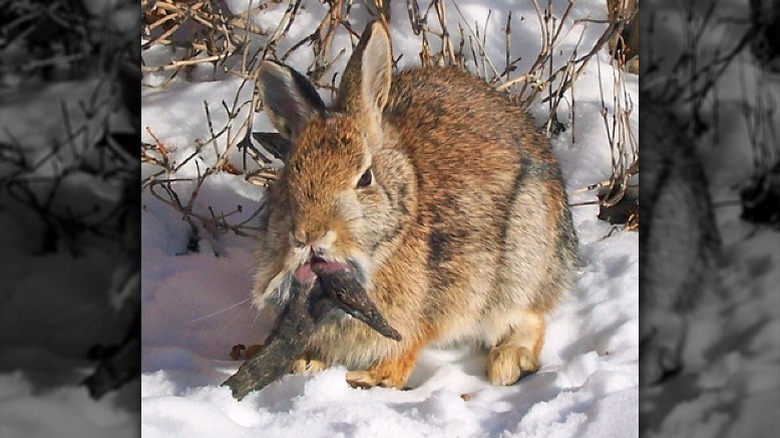The Viral Tentacle Bunny Is More Heartbreaking Than Everyone Thinks
From frankenbunnies to zombie rabbits to mutant hares, people have been having fun with their monikers for the bizarre sightings, but the situation is anything but funny. Earlier this summer, residents in Fort Collins, Colorado, began spotting wild bunnies with a rather disturbing appearance and sharing pics on social media. Instead of their cute, traditional look, these rabbits have what appear to be dark, hairy tentacles sprouting from their heads or faces. The reason? The cottontail rabbit papilloma virus, formerly known as the Shope papilloma virus.
Rabbits in Colorado spotted with tentacle-like growths on their heads from rare virus pic.twitter.com/6KWxbvCYcb
— FearBuck (@FearedBuck) August 12, 2025
The first documented case of the virus dates back to 1933. Dr. Richard Shope (hence the original virus name) and a fellow scientist began studying the wart-like tumors on cottontail rabbits in the midwestern United States. They managed to extract the infectious agent and inject it into healthy rabbits, which developed the same tumors. These tumors can grow on a rabbit's face, head, and legs. After additional testing in the years that followed, it was discovered that the virus can be transmitted from rabbit to rabbit via outdoor bugs and blood-sucking insects like ticks and mosquitoes.
Fast forward to 2025, and the virus still affects wild cottontail rabbits in the midwestern United States and elsewhere. In addition to Colorado, there have been cases in South Dakota, Nebraska, Kansas, Nevada, New Mexico, Texas, and even Mexico. The good news is, the papilloma (tumors) disappear within 6 months of infection in about 35% of naturally infected rabbits. The bad news is, the virus can still cause problems for the rabbits within those 6 months and be deadly for the other 65%.
The virus can indirectly harm or even kill rabbits
Sadly, in addition to creating an unsettling appearance, the tumors can sometimes be uncomfortable for infected rabbits. They can grow so large or long that they affect their ability to eat or see. This could lead to malnutrition, starvation, or impaired vision, leaving them more vulnerable to predators. In some cases, the papilloma can also develop into malignant squamous cell carcinomas, a potentially fatal type of skin cancer.
Since transmission primarily occurs via biting insects that carry the virus from one rabbit to another, wild rabbits can easily become infected. Direct contact between an infected and healthy rabbit can also spread the disease. Domestic rabbits that are kept outdoors, where they could come in contact with an infected wild rabbit or any biting insects carrying the virus, are also at risk. However, if a domestic rabbit becomes infected, a veterinarian can surgically remove the warts.
Wondering if the virus can harm you, your pets, or other wildlife? It can't. The virus only affects rabbits and poses no threat to humans, domestic pets, or other wild animals. However, you still shouldn't touch an infected rabbit if you encounter one. Call a local wildlife official instead to report the sighting. Just keep in mind that the call might not help the rabbit much, unless it's captured and taken to a vet for surgical removal of the tumors; despite almost a century of research, there is currently no cure for the virus.

